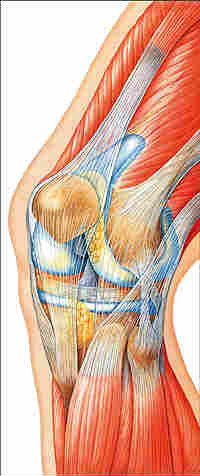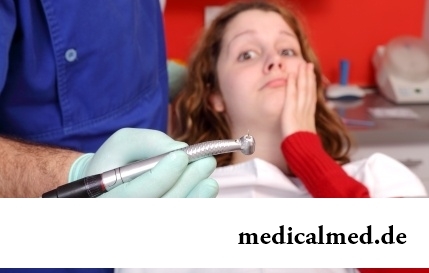





Shlyatter's disease
In essence Shlyatter's disease represents a necrosis of a cartilaginous and bone tissue of the upper site – a tuberosity osteochondropathy - a tibial bone.
Shlyatter's disease: symptoms, reasons, diagnosis
 In most cases Shlyatter's disease develops rather slowly and affects only some one shin. Patients complain of such symptoms of a disease of Shlyatter as a swelling and the morbidity in the place of accession of a sinew by the four-head of a muscle of a hip to a patella in an upper part of a shin amplifying during the walking, squats and pressing. The course of a disease has chronic character with the aggravation periods.
In most cases Shlyatter's disease develops rather slowly and affects only some one shin. Patients complain of such symptoms of a disease of Shlyatter as a swelling and the morbidity in the place of accession of a sinew by the four-head of a muscle of a hip to a patella in an upper part of a shin amplifying during the walking, squats and pressing. The course of a disease has chronic character with the aggravation periods.
Most often Shlyatter's disease is diagnosed for teenagers from nine to eighteen years, especially male. The reason of its emergence consider the damage caused by excessive influence of a knee sinew to the place of the fastening to a tibial hillock and, there can be both single direct influence, and regular microtraumas.
The risk group is made by the boys doing injury-causing sports – soccer, hockey, etc. The similar situation quite often develops as a result of shortening of a sinew of a patella, however according to the world statistics, only five percent of all patients with Shlyatter's disease do not play sports.
Intensive growth rates of the teenager, regular muscular exercises are transmitted through a sinew on tuberosity of a tibial bone, provoke its separation, and also an inflammation and dystrophy of a sinew.
At X-ray inspection of this area note destruction (fragmentation) of this site of a tibial bone. For the purpose of diagnosis of a disease of Shlyatter also apply ultrasonography, radio isotope scanning, local densitometry and laboratory researches, and in some situations – a computer or magnetic resonance tomography.
Treatment of a disease of Shlyatter
Treatment of a disease of Shlyatter first of all consists in stopping of a pain syndrome by means of modern anesthetics of drugs. Patients need to provide rest of an extremity, to avoid the excessive exercise stresses demanding bending of a knee. As a rule, symptoms of a disease of Shlyatter pass several weeks later.
 In treatment of a disease of Shlyatter efficiency of an electrophoresis with calcium and Procainum, lidocaine, cocarboxylase, Aminophyllinum, and also ozokeritovy, paraffin and mud baths, medical massage, physical culture and sanatorium treatment is noted.
In treatment of a disease of Shlyatter efficiency of an electrophoresis with calcium and Procainum, lidocaine, cocarboxylase, Aminophyllinum, and also ozokeritovy, paraffin and mud baths, medical massage, physical culture and sanatorium treatment is noted.
In certain cases for treatment of a disease of Shlyatter can be required imposing of a plaster bandage or administration of steroid drugs directly to the area of an inflammation. Surgical treatment of a disease consists free fragments of a bone at a distance; can also be required to make in it an opening for the purpose of acceleration of healing or even change. The rehabilitation period after surgical intervention can make from several months to one year.
Effects of a disease of Shlyatter
Contrary to a popular belief Shlyatter's disease does not pass. Its treatment represents long process (up to several years), however at the timely address and persistence an outcome for patients favorable. Most of patients recover from Shlyatter's disease after completion of process of growth. In certain cases after recovery cones in patellar area can remain. Also meteosensitivity manifestations can become one of effects of a disease of Shlyatter.
Statistically, on Mondays the risk of getting injured of a back increases by 25%, and risk of heart attack – for 33%. Be careful.

The climax, or menopause is the normal process of the termination of genital function of the woman which is followed serious hormonal...
Section: Articles about health
The unpleasant feelings connected with spring breakdown are familiar almost to each of us. Often happens that in March-April on the person weakness leans: he suffers from drowsiness, complains of bad mood, loss of interest in life and failures in affairs....
Section: Articles about health
More than a half of the married couples which faced prostatitis – leave. The new broadcast "Female View of Prostatitis" will help to learn – whether you have or your relatives problems....
Section: Articles about health
Statistically, can only one of ten of our compatriots brag of a decent condition of an oral cavity. On среднестатистич...
Section: Articles about health
Since the moment when the child becomes a school student, his sight begins to be exposed to the strengthened loadings which are supplemented with viewing of animated films and long computer games. During this period of life of the child development not completely created bodies to a zra...
Section: Articles about health
All parents are ready to what the baby often and pisat much. Since then, as the absorbing diapers strongly became current, keeping of the kid in dryness does not represent any problems. But if the grown-up kid continues to urinate in panties, parents begin to feel concern – whether it is normal, or the kid has an urine incontience? Let's try to understand what is enuresis why it arises at children and at what age it is necessary to begin it to treat....
Section: Articles about health
The name of this disease precisely reflects the problem reason: it consists in the bra fastener pressure upon a certain zone...
Section: Articles about health
Almost each of us during life faced dissatisfaction with own body. At such moments, as a rule, we begin to shame ourselves, urgently we go on the most rigid diet promising minus of 10 kg in a week, or we exhaust ourselves in the gym to полусм...
Section: Articles about health
Partial and the more so full loss of hearing significantly reduces quality of life. Difficulties with communication lead to loneliness and isolation. The person who badly hears experiences difficulties with social and professional implementation, quite often has problems in private life....
Section: Articles about health
Nightmares belong to the most unpleasant frustration. Statistically, they happen at 4% of adults, and almost at 70% of children and...
Section: Articles about health
For the city dweller the fitness is the most convenient sport. It is enough to acquire the subscription to the gym to get access to various apparatuses and an opportunity to train under the leadership of the experienced consultant. Many consider fitness on...
Section: Articles about health
During foot walks blood moves on vessels more actively and one and all bodies are supplied with a large amount of oxygen. It affects the state of health of the person very positively....
Section: Slideshow
Antibiotics - - it is possible to call the chemical compounds suppressing growth of bacteria the break in the field of medicine which allowed to save persons...
Section: Articles about health
The popular expression "run from a heart attack" became the motto of the people supporting active lifestyle. Moreover, run became a peculiar fashionable tendency: sales of racetracks and the accompanying goods for run are at permanently high level. Really...
Section: Articles about health
Cold, puffiness of a nose, itch, the watering eyes - characteristic symptoms of the allergic rhinitis resulting from hit of allergens (pollen, house dust, hair of animals, etc.) on a mucous membrane of a nose. Unpleasant feelings often give trouble, serving as the reason of a headache, an acrimony, sleep disorders, and in certain cases and the states close to a depression. How to get rid of undesirable satellites of a disease if near at hand there are no antiallergic...
Section: Articles about health
Summer in the heat. Many are going to spend vacation abroad. Travelers the tender seas, rest on beaches wait, for survey достоп...
Section: Articles about health
Impossibility to conceive the child – a trouble of many Russian families. During quite long time was considered that main "culprits" of troubles such are women. Modern physicians claim that the situation is different: about a half of failures at...
Section: Articles about health
Transfusion of donor blood has almost century history. In spite of the fact that this procedure is quite usual for many people, process of blood donation is still surrounded with numerous myths. Today we aimed to discredit the most widespread of them....
Section: Articles about health
For anybody not a secret that the modern person eats not as his ancestors. For the last 100 years in broad access appeared with...
Section: Articles about health
Ability of an organism to resist to adverse environmental factors (to impact of temperature drops, humidity and pressure, to the attacks of causative organisms, etc.) directly depends on what the person eats. Business here not only in, that C...
Section: Articles about health
Stroke (acute disorder of cerebral circulation) – one of the most widespread neurologic diseases. Annually in the world more than 6 million people die of this illness. From the survived patients about 80% become disabled people, and nearly a third from them needs afterwards permanent care. In fact, the stroke creates a situation at which a part of cells of a brain loses blood access, loses an opportunity to receive oxygen and nutrients, and perishes. As a result of a razviv...
Section: Articles about health
Small appetite at the child – the complaint which pediatricians should hear practically from each mother. Most often it is carried to разр...
Section: Articles about health
80% of women at least once to lives complained of discomfortable feelings to breasts, consolidations and nagrubaniye. These are mastopathy symptoms. The mastopathy is characterized by change of a ratio between ferruterous and connective tissue tissues of mammary glands. It can bring...
Section: Articles about health
Good appetite was always considered as a sign of good health. The correct operation of the mechanism which is responsible for the need for nutrients and receiving pleasure from process of its satisfaction demonstrates that the organism functions without special deviations. On the other hand, appetite of the person is not a constant. It depends on the culture of food, flavoring addictions imparted since the childhood which can change during life, weather, mood and many д more than once...
Section: Articles about health
All are familiar with cold, and practically everyone believes that he has sufficient knowledge and experience that correctly to treat it. N...
Section: Articles about health
What is in our understanding weeds? It plants which are considered to be suitable only for compost pits and feeding of animals. Meanwhile, among the weeds growing literally under legs it is possible to find the mass of the officinal herbs possessing invaluable Paul...
Section: Articles about health
Herpes simplex of the first type (the infectious disease which is shown periodic bubble rashes on lips is called) – one of the most widespread illnesses. Statistically, only 5% of inhabitants of our planet are unreceptive to its activator, and the reasons of this feature are still not found out. Other people are virus carriers....
Section: Articles about health
